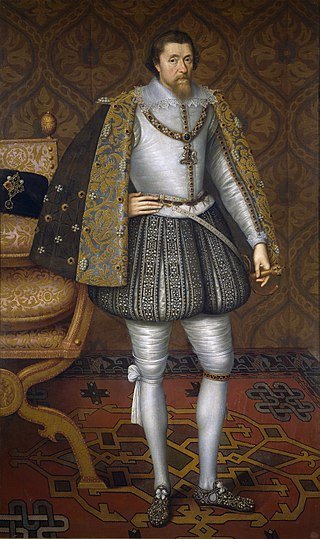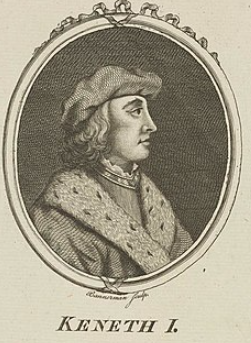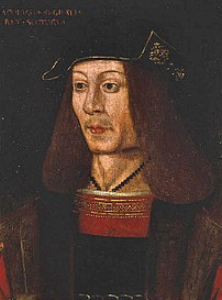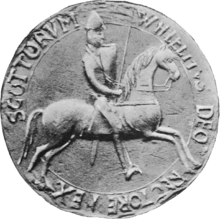Kings and Queens of Scots: 10 Most Influential Scottish Monarchs and their Reigns
The lives of the monarchs of the Kingdom of Scotland were immensely fascinating, from succession plots, invasions and conflicts against the Vikings and England, failed marriages to some major achievements that shaped the future of Scotland.
Here are some of the most influential monarchs that ruled the Kingdom of Scotland:
Robert the Bruce (Robert I) (reign: 1306-1329)

A warrior king in all sense and purpose, Robert the Bruce came to be hailed as national hero for his war efforts against England for the independence of Scotland. Image: Bust of Robert the Bruce at the National Wallace Monument in Scotland
Next on our list of influential Scottish monarchs is none other than Robert the Bruce, also known as Robert I. This King of Scots was perhaps the fiercest and most highly regarded warrior during his time. Robert was best known for fighting against the English and securing Scotland’s independence.
The Bruce family had moved to Scotland by the 12th century and they were related to the Scottish royals through marriage. In 1290, Robert’s grandfather made a claim for the Scottish throne. However, the then-English King Edward I, who had invaded Scotland, decided to make John de Balliol the ruling monarch instead. Eventually, Edward and Balliol’s relationship soured, and Robert sided with Edward in a plot to overthrow the Scottish ruler.
But Robert’s loyalties shifted, perhaps using these alliances to get closer to the crown. He was successful and after killing the nephew of Balliol, declared himself King of Scotland.
Robert’s reign started off badly as he was dealt a lot of defeats at the hands of the English. But he was a smart man and a great military tactician. He managed to keep his kingdom relatively out of reach of the English.
Edward’s later death and his much weaker son, Edward II, also helped Robert in his counterattack. He eventually defeated Edward II at the Battle of Bannockburn in 1314. In the years that followed, Robert and his armies became a huge thorn in the flesh of the English as he attacked many part of northern England as well as Ireland.
In 1324, the Pope John XXII declared Robert as the King of an independent Scotland. Four years later, England, then under the rule of Edward III, and Scotland signed a peace treaty, where England renounced its claim of Scottish crown.
Robert died of leprosy in 1329 but not before making a request to the Pope that all future kings be anointed during their coronation. The Pope granted that request.
The warrior king’s body was buried at Dunfermline. His heart, however, was buried in Melrose Abbey.
He was succeeded by his son David II. It is said that all Scottish monarchs that followed after 1329 were the descendants of Robert the Bruce. What this means is that James VI of Scotland (also James I of England) and his descendants can trace their lineage to Robert the Bruce.
Did you know: Robert the Bruce was involved in William Wallace‘s rebellion against England?
Macbeth (reign: 1040-1057)
One of the most notable rulers in Scotland’s medieval era was Macbeth. This figure, popularly known in William’s Shakespeare’s play “Macbeth”, was very much real and very much different from the play.
Macbeth was also a very influential ruler who not only strengthened the kingdom, but also brought so much peace following the tumultuous reign of his predecessor, Duncan.
Macbeth was 35 years old when he was crowned King of Scotland and his biggest accomplishment during his 17-year reign was ensuring that life was relatively calm and peaceful during his reign. He was also known for his generosity, and together with his wife, Gruoch, he donated to and supported the Church. The king also ensured that the women and orphaned children in his kingdom were well-protected. Macbeth’s reign was hailed for efforts at promoting gender equality. The Scottish monarch passed a law allowing daughters to have the same inheritance rights as sons.
During this era, successions were bloody affairs and even the king had had a hand in the overthrowing of Duncan. As a result, the latter part of Macbeth’s reign was filled with conflicts and invasions. Those conflicts were largely led by Duncan’s son, Malcolm, who eventually killed and defeated Macbeth to become the next King of Scotland.
James VI of Scotland (reign: 1567-1625)

After the death of the last Tudor monarch, Queen Elizabeth I, in 1603, the English crown passed on to her Scottish cousin, James VI of Scotland. James thus became James I of England. And so, the two crowns were united under one ruler.
Much like his mother, Mary, Queen of Scots, James VI of Scotland was only an infant (thirteen months old) when he ascended the throne as King of Scots following her forced abdication in 1567. Through his mother’s side, he inherited the English throne after the death of his English cousin Queen Elizabeth I, who died in 1603. James was then crowned James I of England on July 25 that year.
Because he was so young, James was brought up by advisors. But that seemed to help the young king, and he grew into an intelligent young man. James’s excellent style of conflict management, earned him the reputation as “the most effective ruler Scotland ever had.”
Aside from being one of Scotland’s best rulers, he was also one of the few that ruled for many decades. James ruled Scotland for almost 58 years, and for the most part, the reign was an extremely successful and prosperous rule. Unlike his mother, whose life had been filled with failed marriages, accusations of treason, and tensions between Scotland and England, James rather united both kingdoms (and Ireland) under the leadership of a single ruler, a move which was called the “Union of Crowns.” This union made him the first king of Great Britain and Ireland.
It was during James’s reign that the British colonization of the Americas began. Three years after ascending to the English throne, the king issued charters (to the Virginia Company of London) for the establishment of permanent English settlements in North America. This effort of his explains why the first permanent and thriving English settlement in the Americas was called Jamestown (located in today’s Virginia, United States). The settlement was abandoned in 1610 and 1699.
Following in the footsteps of his predecessor, James I allowed literature and arts to thrive; as a result, the careers of the likes of William Shakespeare and Francis Bacon grew tremendously.
James is also credited with providing funds for the translation of the Bible for the Church of England. The translation, the King James Bible, was commissioned in 1604.
Through his marriage to Anna, who was the sister of the Danish king, Christian IV, they welcomed several children. However, only three would survive past infancy: Henry, Charles and Elizabeth. When James died in 1625, his only legitimate surviving son Charles succeeded him and was crowned Charles I (reign: 1625-1649).
As monarch of the three realms (Scotland, England and Ireland), James chose to settle in England as it was the biggest and most prosperous of the three. James only returned to the country of his birth once, in 1617.
Constantine II (reign: 900-943)
Even though he was the grandson of Kenneth MacAlpin, Constantine’s early life was vastly different from that of other royals. For the most part of his early years, he lived in exile after his father, Aed, had been killed by his rival, Giric.
Together with his cousin, Donald, the pair avenged Aed’s death by killing Giric. With their enemy defeated, Donald became king of the Picts but his reign was cut short after he was killed by the Vikings. His cousin’s passing meant that Constantine was now the King of Pictland.
Much like his grandfather, Constantine II spent most of his reign fighting against the Vikings, and he managed to hold them off. With his victory secured, Constantine set about reviving his kingdom. He introduced the ruling system of mormaers who were left in charge of various provinces within the kingdom. Constantine II also renamed Pictland Alba and extended its influence throughout Scotland.
Constantine II is regarded as one of Scotland’s most successful kings in the Dark Ages. He was a great military tactician and intelligent diplomat. He used those skills to great efficiency as he launched what was later known as the Kingdom of Scotland.
Mary, Queen of Scots (reign: 1542-1567)

What is so unique about Mary was that she was crowned queen of Scots in 1542 when she was only six days old! Her father, King James V, died a week shy of her birth, leaving her as the only descendant with a legitimate claim to the throne.
Mary was initially betrothed to Prince Edward, who was the son of the English king, Henry VIII. But the Scots backed out of the agreement, resulting in a war between England and Scotland, dubbed the “Rough Wooing.”
The young queen fled to France, where she wed a French prince called Francis, the Dauphin of France (i.e. the heir apparent to the throne of France), in 1558. A year later, Queen Mary became consort of France as her young husband had ascended the throne. This marriage arrangement was part of Scotland’s strategy to gain Catholic support against the English Protestants. The marriage lasted until 1560 when the Francis, then-Francis II of France, died. Mary was widowed at the age of nineteen.
She returned to the Kingdom of Scotland only to find that it was going through a Reformation, and as a result, had been divided into Catholic and Protestant factions. Mary married a Protestant nobleman called Henry, Lord Darnley to help secure the kingdom. But the marriage was doomed right from the start. Darnley grew increasingly jealous of his wife’s relationship with her secretary and murdered him. At that time, Mary was pregnant with the couple’s son, James. Despite the couple’s background, their son was baptized Catholic, which caused the Protestants to panic.
Later, Darnley died under mysterious circumstances in an explosion. Once again, the Queen of Scots was widowed. However, an autopsy revealed that he had been strangled. Mary then married her formerly rumored lover, James Hepburn. The marriage was not approved some of the her nobles, and Mary was imprisoned and later forced to abdicate the throne (in 1567) in favor of her infant son, who became James VI of Scotland.
With the help of the few allies she had, the queen later broke out of prison and escaped to England, where she got entangled in English politics and spent nineteen years in different castle under house arrest. Eventually, she was accused of plotting against Queen Elizabeth I and executed in 1587.
Mary was survived by her son, James, who later became James I of England and VI of Scotland. He would later rebury his mother at Westminster Abbey.
Read More: Queen Elizabeth I’s deadly feud with Mary, Queen of Scots
Kenneth MacAlpin (reign: 843-858)

Portrait of Kenneth by Scottish engraver Alexander Bannermann, 18th century
Kenneth MacAlpin is often recognized as the first king of medieval Scotland and even the founder of Scotland. He spent much of his reign battling against the Vikings, and he was quite successful in his efforts.
The king was responsible for bringing the Gaels and the Picts together to form a united kingdom, which was later known as Scotland. With the birth of Scotland, Kenneth established a capital called Dunkeld. This city became an important Christian site because Kenneth had transferred relics belonging to the Irish missionary, Saint Columba.
Following his death in 858, he was succeeded by his brother, Donald I.
David I (reign: 1124-1153)
David I was the son of Malcolm III and an English woman named Margaret. While in court, Margaret had introduced certain English cultural and religious practices, which encouraged Catholicism over the Gaelic Christianity. As a result, when his parents died, David and his siblings left for England with the throne being handed over to Malcolm’s brother, Donald III.
David eventually became King of Scotland after the reigns of his uncles, Edgar and Alexander I. He was regarded as a very efficient and good ruler who expanded the kingdom and constructed many castles and monasteries. He was also a skilled military officer who capitalized on the death of his brother-in-law, King Henry I of England, to launch attacks against northern England. Constantine was also known for his piety, and some even felt that he was too religious for his own good. He founded several churches, including Melrose and Holyrood.
He died in 1153 and was buried at Dunfermline. David I was succeeded by his grandson, Malcolm IV.
James IV (reign: 1488-1513)

King James IV of Scotland succeeded his father James III, who was an unpopular ruler. When his father died, James regretted his involvement in his father’s death and wore an iron belt as a form of punishment. He was 15 when he became king.
James was an intelligent ruler who spoke several languages, including Latin, French, and Flemish. He was also interested in different academic fields like chemistry and alchemy.
Through his love for education, he established the very first department of medicine in a university and also built a surgeon’s college, as well as a printing press. The king was a big patron of the arts. This probably explains why his court became known for hosting many entertainment shows.
He had immense power over Scotland and used his influence to interact with the Scottish people. James IV’s love for Scotland, education, the arts, and architecture made him the perfect ruler to lead Scotland out of the medieval era into the Renaissance.
James IV died in 1513. He was killed in fighting against the English at the Battle of Flodden. Upon his death, he was succeeded by his only surviving child, James V.
By marrying Margaret of Tudor, the sister of Henry VIII of England, James IV brought descendants that ended up being heirs to the English crown. In 1603, one of James IV’s descendants, James VI of Scotland, inherited the English Crown from the childless Elizabeth I.
Malcolm II (1005-1034)
In 1005, Malcolm II became the King of Scots after killing his cousin Kenneth II. He had two major goals in his quest for the throne, with the first being securing his family in the line of succession, and the second being a plan to expand Scotland. He was the grandfather of the Macbeth, Scotland’s most popular ruler.
Malcolm spent a lot of time during his reign fighting against Nordic settlers in northern Scotland. He struggled at first, eventually finding success in 1016. He also invaded Northumbria in the Battle of Carham, which helped him further establish Scotland.
Because Malcolm had no surviving sons, his grandson, Duncan I, succeeded him upon his death in 1034.
William the Lion (1165-1214)

Seal of William the Lion, King of Scots
William the Lion was the brother of King Malcolm IV and became king after the death of Malcolm. He was the second longest monarch to reign over Scotland. William had a fairly good reign, but he also suffered setbacks, especially in his attempts to conquer Northumbria from England.
But William still had many achievements to his name. He founded Arbroath Abbey, where he would later be buried. Another interesting point to note was his sobriquet, which he earned after his death. “The Lion” suffixed became his name because his flag depicted a red lion placed on a yellow background. His flag later became the royal flag of Scotland, which is still used in contemporary times.
A revolt against England’s King Henry II in 1173-1174 saw William lose part of Scotland, and he only regained control by signing the Treaty of Falaise. The treaty was enforced for 15 years until the new English king, Richard the Lionheart, agreed to revoke the agreement in exchange for 10,000 silver marks.
Upon William the Lion’s death in 1214, his son Alexander II (reign: 1214-1249) was crowned King of Scots.
























